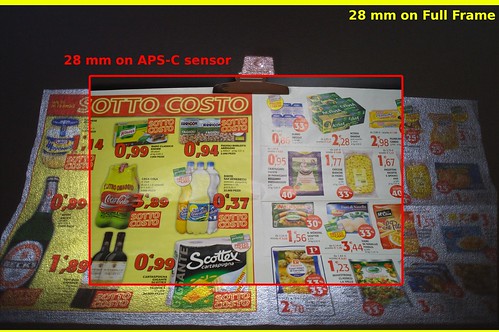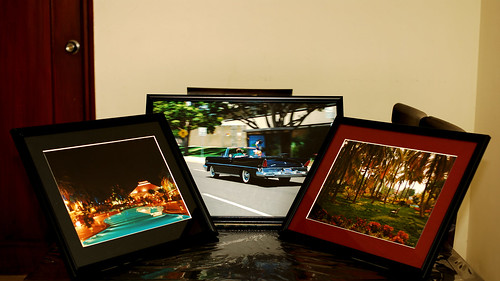Tutorial - difference between full frame and APS-C sensor24x36
Image by funadium
This is the difference between a shot with a full frame analog camera and an APS-C digital camera.
I removed the back of my Pentax MX and used a piece of tracing paper instead of a film so you can see what happens inside the film camera while shooting.
The quality of the image projected on tracing paper is not high, but enough to exactly understand the size of the size of the framed image.
The grainy part with the yellow border is a shot of what is projected by the lens on the full frame film.
The sharper part with a red border is a shot of the same advertising made with the same lens mounted on the K100D, APS-C format.
The lens project always the same image, with the same dimensions, but the APS-C sensor uses only the central piece.
The feeling, then, is the lens become "longer", because it takes a smaller field, but it is just a feeling.
If the image would be printed with the same enlargement (NOT on the same paper format!) the print from the digital would be 1.5 times smaller.
So, if the classical 10x15 cm photo is printed from an APS-C digital without to increase the enlargement used for the film the print become 6x10 cm, independently from the number of megapixels of the camera.
Questa è la differenza tra uno scatto con una macchina a pellicola full frame e una digitale con sensore APS-C.
Ho tolto il dorso dalla mia Pentax MX ed ho usato un pezzo di carta da lucido invece della pellicola così potete vedere cosa succede nella macchina mentre si scatta.
La qualità dell'immagine proiettata su carta da lucido non è elevata, ma è sufficiente per capire esattamente la dimensione dell'immagine inquadrata.
La parte granulosa col bordo giallo è uno scatto di cosa viene proiettato dall'obiettivo sulla pellicola.
La parte più nitida col bordo rosso è uno scatto della stessa pubblicità fatto con lo stesso obiettivo montato sulla K100D, col sensore in formato APS-C.
L'obiettivo proietta sempre la stessa immagine, con le stesse dimensioni, ma il sensore APS-C ne utilizza solo la parte centrale.
L'impressione è quindi che l'obiettivo sia diventato più "lungo", perché abbraccia un campo minore, ma è solo un'impressione.
Se l'immagine fosse stampata con il medesimo ingrandimento (NON sullo stesso formato di carta, badate bene!) la stampa da digitale sarebbe una volta e mezza più piccola.
Quindi se la classica foto 10x15 cm venisse stampata da una digitale APS-C senza aumentare l'ingrandimento rispetto alla pellicola la stampa diventerebbe solo 6x10 cm circa, indipendentemente dal numero di megapixel della macchina.
Framed
Image by code_martial
I got 14 of my photos framed in various sizes last month. Four have been given out as gifts. The rest are slowly going up on my walls.
Photography isn't complete until you get prints and have them presented in an album or frames. Well, it also makes you realise how bad some of those photos really are :p
Some of our photos framed
Image by Valerie Everett
Some of our photos we printed to 8 by 10 size.
Tutorial - full frame
Image by funadium
For the description click the image below.
Lens used on the Pentax MX: SMC Pentax-M 28/2.8.
Lens used on the Pentax K100D: Sigma 50/2.8 EX DG macro.
Projection screen: a piece of tracing paper.
Per la descrizione cliccare l'immagine sotto.
Ottica usata sulla Pentax MX: SMC Pentax-M 28/2.8.
Ottica usata sulla Pentax K100D: Sigma 50/2.8 EX DG macro.
Schermo di proiezione: carta da lucido.
No comments:
Post a Comment